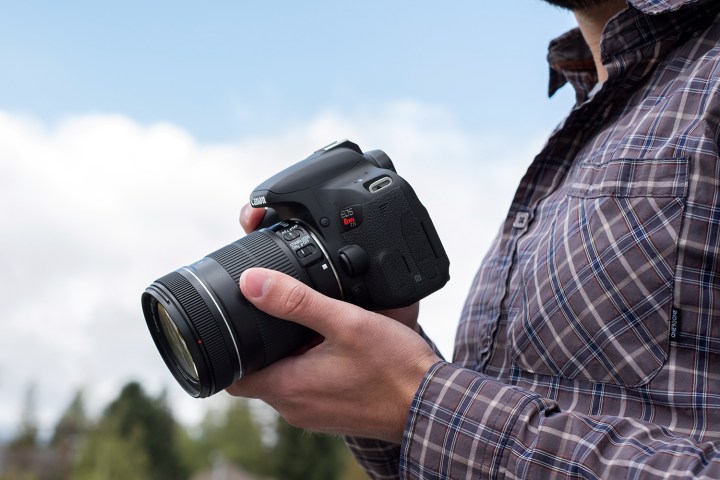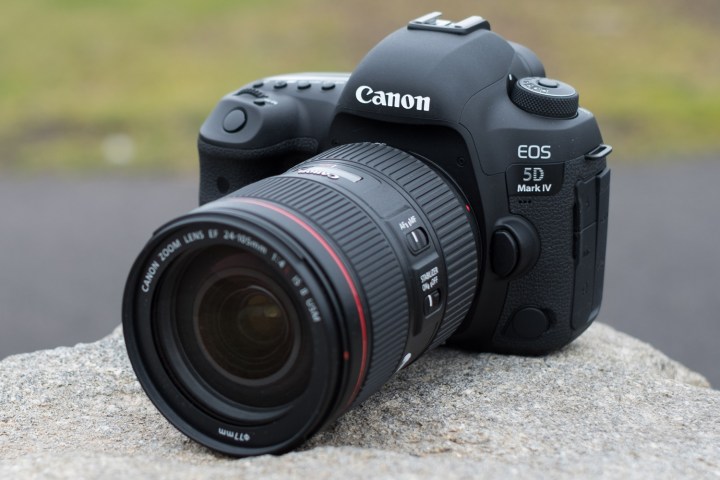The core feature of a DSLR is the optical viewfinder, which uses a mirror to let you see directly through the lens on the camera. The latest DSLRs offer stronger performance and features than earlier models, as well as the ability to capture high-quality videos. So if you’re in the market for a new DSLR or looking to trade up, here are our current favorites.
Nikon D3500
Best DSLR camera overall

Why should you buy this: Beginner-friendly DSLR features in a compact body
Who’s it for: Travelers and first-time DSLR buyers
Why we picked the Nikon D3500:
Nikon’s entry-level DSLR isn’t just ideal for beginners — at 12.9 ounces, it’s the company’s most portable DSLR and is even lighter than Canon’s 15.8-ounce Rebel SL3. The D3500 uses a re-designed body with both a compact size and better ergonomics. The design is geared towards beginners with a simpler control scheme and a Guide Mode for learning photography tips right from the back of the camera.
While compact, the Nikon D3500 still fits in a 24-megapixel APS-C sensor that offers much better image quality than a phone camera. The D3500 only snaps 5-fps bursts and uses an 11-point viewfinder autofocus system (a far cry from the 151-point system in the Nikon D850), but it also starts at a very affordable price. Video tops at Full HD 1080p, and you don’t get anything like the fast Dual Pixel Autofocus to help you out. But for beginning still photographers, the D3500 offers plenty to inspire you to move beyond your phone and into the world of interchangeable lens photography.
If size and portability are your primary concerns, you may be better off looking at one of the best mirrorless cameras. But if you’re already a Nikon DSLR owner, or you want the better battery life that comes with a DSLR’s optical viewfinder, the D3500 is a great value.
Why we love it:
- Great for beginners looking to move beyond smartphone photography
- Portable, light, and easy to use
Canon EOS Rebel T7
Best value DSLR

Why should you buy this: Performance, features, and ease of use loaded in an affordable package.
Who’s it for: First-time DSLR buyers on a budget
Why we picked the Canon EOS Rebel T7:
Built around the same sensor and autofocus systems as the more expensive EOS 80D, the T7 packs a serious punch for an entry-level camera. With a 3-frames-per-second burst rate, it won’t have any trouble keeping up with your kid’s little league game. But performance isn’t the only thing that makes the T7 a great camera. It also incorporates the EOS Utility Webcam Beta Software to make your camera into a high-quality webcam. This makes the T7 as approachable as it is powerful, and it is truly one of the most well-rounded cameras available for beginners and budget-conscious enthusiasts, alike.
Why we love it:
- Doubles as a webcam for vlogging
- Entry-level camera with great performance
Nikon D7500
Best DSLR for videos

Why should you buy this: It’s a versatile, strong DSLR for photos and videos.
Who’s it for: Someone who wants the best of the best in the world of recording DSLRs.
Why we picked the Nikon D7500:
Nikon’s flawless autofocus offers excellent performance while recording video, something that many other DSLRs struggle with, and the D7500 helped bring the feature into the mainstream. The Nikon D7500 is a solid DSLR for video which allows you to record in 4K UHD. The Nikon D7500 also gives you the option to record in MP4 format to playback clips on your smart devices.
Why we love it:
- Great for shooting video
- Top of the line camera with exceptional photo quality
Canon EOS 4ooo
Best DSLR for beginners

Why should you buy this: Full HD 1080p video recording, built-in wifi, and decent battery life
Who’s it for: Great for DSLR beginners
Why we picked the Canon EOS 4000:
If you had to buy just one DSLR, make it the Canon EOS 4000. Canon packed this camera with easy-to-use features that it’s the most basic DSLR you can buy. The 18-megapixel sensor should satisfy a wide range of photographers, and support for full HD makes it a capable video camera. The body of the camera is sturdy, yet lightweight. Canon put built-in wifi on this camera to allow you to instantly transfer all your photos and videos to your phone or smart devices.
Why we love it:
- 18MP clarity, and full HD video capability
- Easy to use for beginners, sturdy and lightweight
Canon EOS 5D Mark IV
Best full-frame DSLR

Why should you buy this: This versatile full-frame camera delivers fast autofocusing and 4K.
Who’s it for: Enthusiasts moving into full-frame
Why we picked the Canon 5D Mark IV:
Full-frame cameras tend to be well-built across the board, and there are many excellent options, but Canon’s EOS 5D Mark IV is our pick. For the price, you get a lot of Canon’s latest tech inside a camera body that isn’t much larger than midrange APS-C DSLRs – great for sports photographers who need to run around or carry multiple cameras. In our hands, the camera felt comfortable to hold, especially during one full day of shooting, from morning to night. The 5D Mark IV is a full-frame camera that will appeal to pros and enthusiasts, particularly those moving into full-frame for the first time.
Besides a newly developed 30-megapixel full-frame sensor and the latest image processor (Digic 6+), the 5D Mark IV uses a 61-point autofocus system and Canon’s Dual Pixel AF system, which provides fast autofocusing when in live view mode. The camera also introduces Dual Pixel RAW, which lets you correct focusing errors afterward. Even in the dark of morning and night, we thought the autofocusing was fast. The camera also has faster continuous shooting, at 7 fps (unlimited when shooting in JPEG), and it’s the first 5D-series model to include Wi-Fi/NFC and GPS. Dual card slots (CompactFlash and SD) lets you write RAW to one and JPEGs to another simultaneously, or use both for redundancy.
The 5D Mark II launched the trend of DSLR filmmaking. Although the 5D-series is no longer the standard-bearer, Canon brought 4K video capture to the 5D Mark IV. The camera shoots very good videos, particularly at Full HD 1080 at 60 fps, but
Canon’s latest 5D is a stellar, versatile full-frame camera that will suit many photographers, whether on the go or in the studio. While it has some nitpicky cons in video, it’s also a strong camera for videography. If you want a camera with faster burst speed, you should look at the Canon EOS-1D X Mark II or Nikon D5. For high-resolution stills, the Canon EOS 5DS is better suited for portrait work. For everyone else, the 5D Mark IV is our go-to.
Why we love it:
- Fast autofocus in any light conditions
- Includes Wi-Fi/NFC and GPS
- Shoot more photo and video with dual card slots
What is a DSLR camera?
DSLRs remain the workhorse cameras for many photographers, from beginners to professionals. Paired with a strong lens, most modern DSLRs are capable of shooting terrific images. Advanced models offer stronger performance, more features, and better construction, but they’ll also command a higher price.
A DSLR is a type of camera that uses interchangeable lenses, and because of the similarity, it’s often confused for mirrorless cameras, which also use interchangeable lenses. DSLRs use mirrors to reflect light from the lens to the optical viewfinder (OVF); when the shutter button is pressed, a mirror flips up to allow light to hit the sensor. Mirrorless cameras do away with the mirror system and OVF (hence the name).
Because of the mirror, DSLRs tend to be bulkier than their mirrorless sibling. However, the OVF shows a more accurate picture (it’s an exact reflection of what you’re shooting), and performs better in low light. DSLRs also offer stronger autofocusing, as well as larger lens options and better battery life. Although many of the latest mirrorless cameras have caught up in performance, making many on par with DSLRs.
Canon and Nikon are the dominant DSLR manufacturers. You’ll also find strong options from Pentax (which has a loyal following) and Sony, but the majority of professionals use cameras and lenses from Canon or Nikon.
Looking to upgrade from shooting photos with your smart phone, taking up professional photography, or just adding another hobby to your list of talents, these DSLR cameras offer the versatility, features and quality that any photographer needs. These cameras come at a range of price points, but they are all stellar options for taking great photos.

